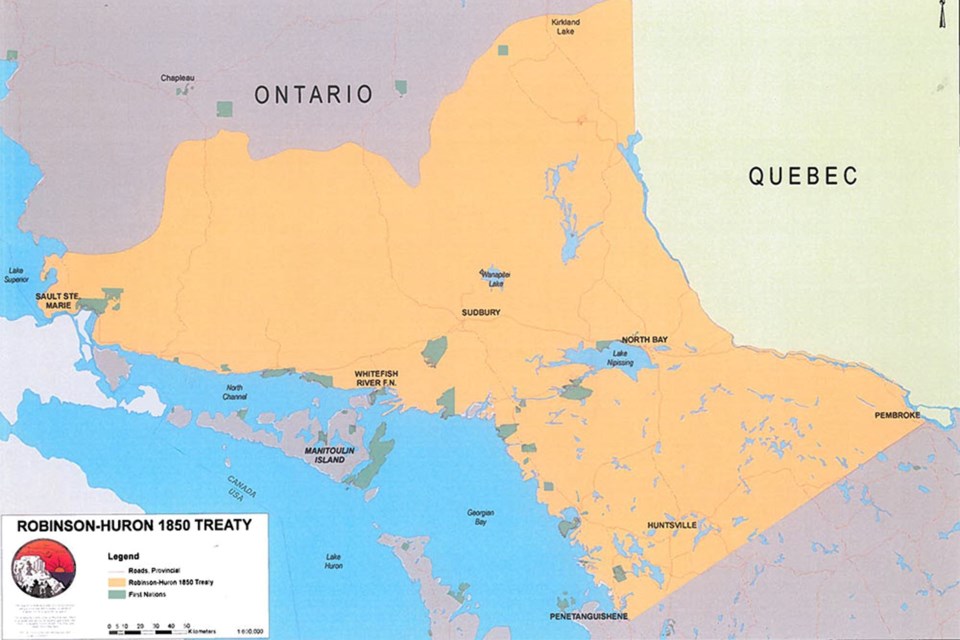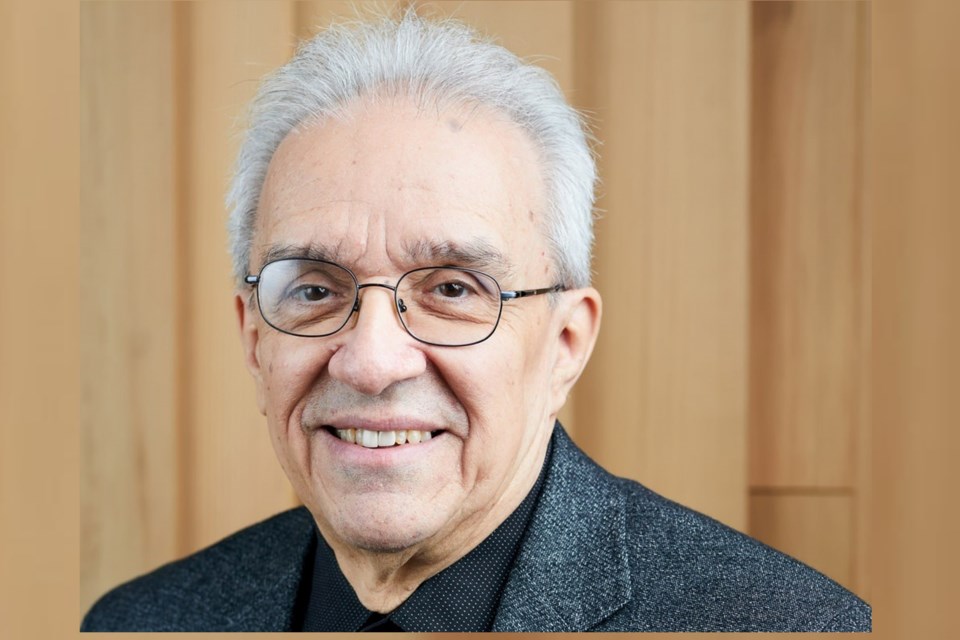Was Justice Harry LaForme fired or did he resign? These are but two questions swirling around the $10-billion Robinson Huron Treaty settlement.
Justice Harry LaForme resigned from the Robinson Huron Treaty Litigation Fund’s (RHTLF) Office of the Mizhinawe last month, shortly after he submitted an interim report. It is unclear if or how the contents of that report created the circumstances that led to LaForme’s resignation, which was the result of community information sessions detailing the recently announced $10-billion RHT settlement.
Now, the previously confidential interim report has been leaked to Sudbury.com. We have independently verified the report we received is the actual report filed by LaForme.
LaForme submitted this interim report detailing his community information sessions on Aug. 25 and sent his resignation letter to RHTLF Sept. 9.
But did he resign?
A Sept. 12 letter written to LaForme by RHTLF Chair Mike Restoule states the RHTLF had a meeting Sept. 1 — eight days before LaForme sent his resignation letter — and voted to end LaForme’s position. That decision, Restoule writes, was based on the report contents, and what he said is the timing of the disclosure that the Toronto-based law firm that LaForme works for as senior legal counsel, Olthuis Kleer Townshend LLP, “has been retained to provide independent legal advice on the proposed settlement agreement.”
In the letter to LaForme, Restoule seems to suggest that the involvement of LaForme’s employer in the situation creates a conflict of interest, though he doesn’t use that term.
“It would have been appropriate for you to make this disclosure to us beforehand, so we could discuss it and agree on a way forward,” Restoule said in the letter.
It is unknown what legal advice Olthuis Kleer Townshend LLP was hired to provide. LaForme notes in the report that to further information findings and recommendations, “my office will be undertaking some research respecting the experience of other First Nations and Indigenous peoples with managing collective compensation, including both situations involving individual payouts and investments of funds at the community level.”
It is unclear if LaForme’s reference to “my office” is a reference to the Office of the Mizhinawe or the law firm he works for. The monies for the Office of the Mizhinawe do not come from the settlement legal fees.
But it is in the wake of LaForme’s interim report that the Sept. 1 meeting of the RHTLF and the Litigation Management Committee (LMC) occurred. The LMC was established by the RHTLF and is composed of two trustees from each Robinson Huron Treaty Anishinaabek sub-region: the Manitoulin sub-region, the North Shore sub-region and the Highway 69 Corridor sub-region.
In his Sept. 9 resignation letter, LaForme states attendees at the Sept. 1 meeting provided him with accounts that describe a raucous meeting with “chiefs being shouted down by other chiefs, a chief being publicly castigated by a member of the legal team,” and “a lawyer for a First Nation being thrown out of the room.”
Why LaForme’s interim report elicited such a strong response is unclear. LaForme hasn’t spoken publicly about it and neither have the chiefs who attended the meeting, from what Sudbury.com has been able to learn.
Laforme said that at the meeting, “resolutions to end my tenure as the Mizhinawe” were also initiated by members of the legal team and a chief in addition to “various descriptions of behaviour” attributed to the litigation team, “the likes of which I have not heard since I presided as a judge over proceedings involving organized crime.”
Again, because of the limited publicly available information, it is unclear what allegations were levelled against the litigation team or what exactly LaForme means when he references organized crime cases.
He states in his resignation letter he received no communication from RHTLF after he submitted his report.
Resignation or Dismissal?
In the letter to LaForme, RHTLF Chair Mike Restoule said a motion was tabled and passed to dissolve the Office of Mizhinawe and “continue the work at the local level” during the Sept. 1 meeting.
Restoule said RHTLF was advised to wait until after the Sept. 9 Robinson Huron Treaty of 1850 Gathering to notify LaForme of their decision, owing to the need, he said, to obtain the guidance of elders and knowledge keepers.
In Restoule's letter, he to told LaForme that the “overly negative tone in your interim report is one of the main reasons the chiefs and trustees decided to discontinue your role and dissolve the Office of Mizhinawe,” and went on to state that the “vast majority of chiefs did not find your report reflected what occurred in their own community sessions.”
As stated, Sudbury.com has a copy of LaForme’s report and it is unclear, based on our reading of the document, why the litigation team found the contents “overly negative”, as the letter to LaForme doesn’t explicitly describe what about the report was found to be negative.

However, Sudbury.com has highlighted some of the contents of the interim report below, which do suggest why the chiefs found the report less than positive.
The information contained in the report is based on the community sessions the Mizhinawe (LaForme) was hired to carry out. The Interim report was created at the discretion of the Mizhinawe and was not requested by the litigation team. LaForme wrote he wanted to show the progress so far, as well as “comment on some key process issues in the consultations.”
These consultations, referred to as the Mizhinawe Naangidoondaa, inform Treaty members about the proposed $10-billion annuities settlement announced on June 17 and also seek their feedback on the process of distributing the settlement amount and paying the lawyers involved.
The settlement stems from the Robinson-Huron Treaty of 1850 Annuities Statement of Claim, which was launched by the RHTLF in 2014 and involved a claim for resource revenues related to the treaty’s annuities clause.
The $10-billion settlement is to compensate for the years the amount was never raised.
For a more detailed explanation on the case, click here.
The Office
The Office of the Mizhinawe was created according to Anishnaabe law, a traditional role that was in place when the treaty was signed in 1850. The meaning is similar to “Near Chief.” The position was created to work in concert with the RHTLF, but independent of them, and recommendations to RHTLF were optional.
Laforme was appointed to the position March 31, ahead of the settlement announcement. Sudbury.com spoke with him in August.
“What we are doing is giving the members a chance to tell us, in their own words, how they think that distribution of settlement monies should go, and they're given the opportunity to get as much information as we can give them,” he said.
The interim report detailed this process.
The Interim Report
The report states that community members expressed the need for more information. In addition to asking for more notice of the meeting dates and more time to digest the information given before the requirement to offer input, the report states “it is also clear that more engagement and communication is necessary to clarify issues for community members.”
There was one meeting where it was noted that “rumours and social media had had a negative effect.”
There were numerous requests for more in-person gatherings, as well as outreach to youth and elders. Many participants requested copies of the information given to them, and questioned why there wasn’t more of it, or more details.
There was also a quote about the faith in current leadership. “In some communities, some were openly distrustful of Chief and Council or questioned the role of the LMC (Litigation Management Committee.)”
Legal: privilege and costs
The report states some found the legal presentation on the settlement agreement and existing CDA “difficult or impossible to understand.”
Treaty members are trust beneficiaries, and therefore not privy to the privileged and confidential information that the RHTLF and LMC possess. This was a point of confusion and document confidentiality is the reason that treaty members can’t access to documents, and receive explanations “only at a high level.”
At least one Ansihnaabe signatory, Garden River First Nation, expressed displeasure with the amount of legal fees, among other aspects of the compensation disbursement agreement. Chief and council released a memo on social media Sept. 9, speaking out against the distribution plan, which leadership says would see lawyers pocket an “unconscionable and outrageous” $500-million fee and Robinson Huron trustees using $1 billion of the settlement to establish a trust fund for future litigation and other needs.
However, the chief and majority of council were recently voted out of office.
In almost every community, there were questions about the specific costs of legal and other professional services incurred by the RHTLF and a “clear expectation that members of First Nations are entitled to this information.”
Individual vs. collective
The $4 annuities cheque each treaty member receives is individual, and raising that amount in future is still in the works. The $10-billion settlement is for past compensation, and is to be split between an individual allotment and an investment for the collective future of each First Nation signatory, as per a compensation distribution agreement developed in the trust indenture.
“It appears that many community members do not understand the rationale and mechanics of the distribution formula,” reads the report. “Accordingly, continued efforts to explain the distribution formula by the RHTLF and LMC are necessary in future sessions.”
There are also questions about who is a treaty member.
“Members in just about every community also have expressed concern about the arbitrariness of aspects of imposed federal law respecting Indian status and how that has been used to determine treaty beneficiary status for the purposes of paying the current Crown controlled $4 annuity.”
The end of The Office
The interim report finishes with three recommendations: more communication, consider additional consultation tools like surveys and home visits, and “communications on transparency respecting legal and other professional fees.”
Then, on Sept. 14, a letter was posted to social media from the RHTLF. It is not dated nor addressed to anyone specific.
“We are grateful for their work to hold these sessions and share information on the settlement and what it means for our communities,” it reads. “These sessions opened important conversations with communities, and we want to continue that.
It states that the Mizhinawe and his team have delivered initial recommendations to the chiefs and trustees and they are working to bring those recommendations to the next stage.
“We heard from you – our community members – about the need for more communication at a community level. We heard from many community members that you want to communicate directly with your Chiefs and Council to have your questions answered and to receive more information,” the letter reads. “Consequently, the Chiefs have decided to discontinue the role of Mizhinawe. In the fall, we will continue to hold sessions with the communities at a local level to provide more information and answer your questions.”
The dates of those sessions have not been released.
For his part, LaForme states in his resignation letter that he is disappointed to learn it was not seen as an opportunity.
“For the record, I stand by the contents of the interim report and I am grateful for the stellar work and contributions of the academics who assisted in writing it.”
He continues to state in the letter that he does not see the point in continuing.
“It does not seem like a good use of time or money — which does not come out of the settlement proceeds — for me to make recommendations that will be summarily ignored,” he said. “I believe Anishinaabe people deserve much better.”
Jenny Lamothe is a reporter with Sudbury.com.
